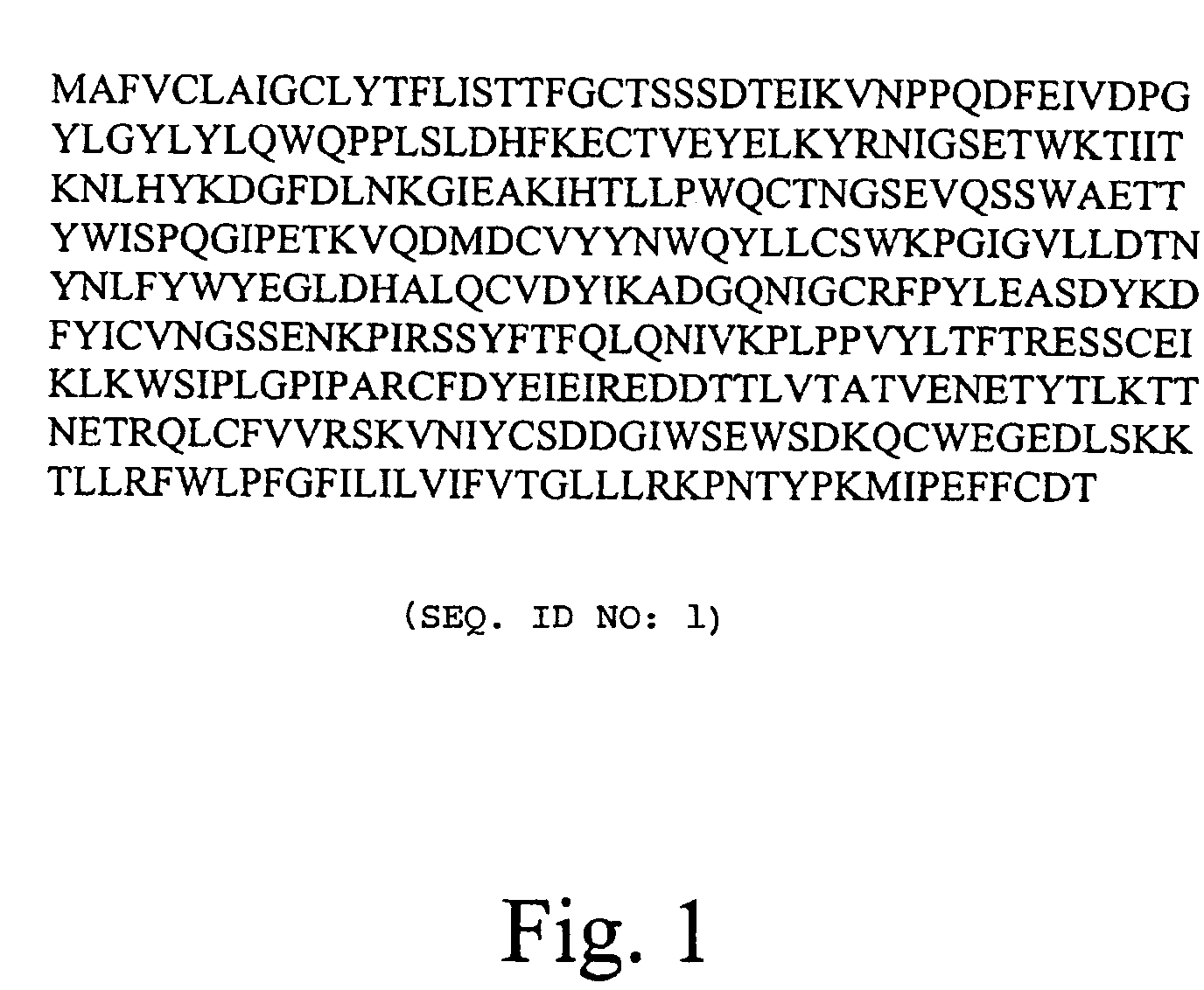Cancer immunotherapy
a technology of immunotherapy and cancer, applied in the field of cancer immunotherapy, can solve the problems of limiting the potential for autoimmune side effects that are observed, and achieve the effects of stimulating an immune response, increasing the titer of antibodies, and increasing the killing of target cells
- Summary
- Abstract
- Description
- Claims
- Application Information
AI Technical Summary
Benefits of technology
Problems solved by technology
Method used
Image
Examples
example 1
IL-13Rα2 Mimics the Biological Features of an HGG-Associated Receptor for IL-13
[0097]Normal Chinese hamster ovary (CHO) cells were transfected with a pcDNA 3.1 plasmid (Invitrogen) containing the full length open reading frame of IL-13Rα2 and positive clones were selected with geneticin. The expression of IL-13Rα2 in these clones was tested for their ability to bind 125I-labeled IL-13. Selected clones were shown to bind labeled IL-13 independently of IL-4. In addition, labeled IL-13 was displaced by IL-13.E13K, a mutant of IL-13 shown to have a greater affinity for the IL-13 binding protein on HGG than for the shared IL-13 / IL-4 receptor found in a plethora of tissues under a physiological state. Furthermore, these IL-13Rα transfected CHO cells were exposed to an IL-13. E 13K-PE38QQR cytotoxin, a fusion protein showing potent dose dependent cytotoxicity on HGG cells. The clones expressing the receptor were killed in direct proportion to their affinity for IL-13, but not CHO cells alo...
example 2
Identification of IL-13Rα2 as a Cancer Testis Antigen
[0098]Materials and Methods
[0099]Sources of RNA. High-grade glioma cell lines A-172 MG, U-373 MG, U-251 MG and human glioblastoma multiforme explant cells (G-48) were grown in culture in appropriate media. Total RNA was extracted from the cells using the acid-guanidium isothiocyanate-phenol-chloroform method. Poly(A)+ RNA was further isolated using the Mini-oligo(dT) Cellulose Spin Column Kit (5 prime-3 prime Inc., Boulder, Colo.). 2 μg of Poly (A)+ RNA was eliectrophoresed on a 1% agarose formaldehyde gel, transferred to 0.45 μm magna charge nylon (MSI, Westborough, Mass.) and UV-crosslinked (Stratagene, La Jolla, Calif.). RNA-blotted membranes were also purchased from Clontech (Palo Alto, Calif.). Two Multiple Tissue Expresrsion (MTE™) Blots (cat # 7770-1 and 7775-1 were analyzed to determine the tissue distribution of the IL-13 binding proteins. Two sets of Human Brain Multiple Tissue Northern (MTN™) Blots (cat # 7755-1 and 776...
example 3
Representative Immunogenic Peptides of IL-13Rα2
[0113]Table I presents a list of IL-13Rα2 peptides that might be used to stimulate an immune response against IL-13Rα2 in a subject. The listed peptides were obtained using a computer program provided by the Ludwig Institute For Cancer Research (Lausanne, Switzerland). This program provided the best (at high stringency) fit of predicted immunogenic peptides that bind specific classes of MHC molecules (i.e., the various alleles of human MHC Class I indicated in Table I). The peptides indicated with the “*” are those that should bind under high stringency. The skilled artisan could produce these peptides as described herein (e.g., by automated peptide synthesis) and use each in a vaccine preparation that would be administered to a variety of test subjects (e.g. those with different MHC types) as also described herein. The immune response stimulated by each of these peptides in the subjects could then be assessed, so that those that stimul...
PUM
| Property | Measurement | Unit |
|---|---|---|
| Time | aaaaa | aaaaa |
| Fraction | aaaaa | aaaaa |
| Fraction | aaaaa | aaaaa |
Abstract
Description
Claims
Application Information
 Login to View More
Login to View More - R&D
- Intellectual Property
- Life Sciences
- Materials
- Tech Scout
- Unparalleled Data Quality
- Higher Quality Content
- 60% Fewer Hallucinations
Browse by: Latest US Patents, China's latest patents, Technical Efficacy Thesaurus, Application Domain, Technology Topic, Popular Technical Reports.
© 2025 PatSnap. All rights reserved.Legal|Privacy policy|Modern Slavery Act Transparency Statement|Sitemap|About US| Contact US: help@patsnap.com



